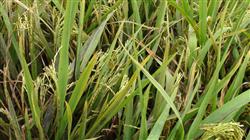Occurrence characteristics and control techniques of rice false smut

First, the occurrence characteristics of rice false smut occur only in the panicle, generally in the rice flowering to milk stage, the infected grain, the pathogen grows in the glume, forming a rice koji with a diameter of about 1 cm instead of rice grain. The optimum temperature for germination and development of false smut pathogen was 25 ~ 30 ℃. The pathogen could not grow above 34 ℃ or below 12 ℃. Rice false smut pathogen can infect the flowers and young glumes of rice. The main stage of pathogen infection was the middle booting stage of rice, but rarely invaded after flowering. From the end of booting stage to the heading stage of rice, if we encounter the climatic conditions of high humidity, suitable temperature and small temperature difference between day and night, it is very conducive to the occurrence and prevalence of the disease. At the same time, there were obvious differences in resistance among varieties, and the occurrence of the disease was positively correlated with unreasonable application of nitrogen fertilizer, and the disease was serious in the fields with light green and low-lying humidity in the middle and later stage of rice. 2. Control techniques 1. Agricultural control: selecting disease-resistant varieties, proper sparse planting, throwing seedlings cultivation must pay attention to sparse throwing, cultivate strong and effective ears, reasonable fertilization, control the amount of nitrogen fertilizer, increase the application of phosphorus and potassium fertilizer, apply fertilizer early to promote early development, control the amount of panicle fertilizer, change the traditional fertilization method to balance promotion method, make rice plants yellow naturally in the later stage, and enhance the disease resistance of rice. Rational irrigation, timely and appropriate shelving and drying of fields. 2. Chemical control: the suitable period of application is 15 days after rice heading (before rice hits the bud and prevents panicle blast). Spray 60 grams of Jinggangmycin or Jinggang with 20% per mu. Pyrimidine 15 ml or 16% well. Ketone. Tricyclazole 150-200g water 50ml 60kg spray control.
- Prev

Occurrence and control of rice blast and rice planthopper
First, the occurrence of rice blast: Rice leaf blast has appeared in Helan, Qingtongxia and other places. The initial period is June 13, about 10 days earlier than last year. Especially after the rainfall on July 7 and 12, the humidity in the field is relatively high, which is very beneficial to the development of leaf blast. The average rate of disease fields in the recent general survey of Qingtongxia is 16.7%.
- Next

Characteristics and control strategies of rice planthopper
Baohe Township, located in the southwest of Jinghe County, is a hilly area. The township has 9144 mu of arable land and 7813 mu of paddy field, which is a typical agricultural township in mountainous areas. Rice planthopper (Nilaparvata lugens) is a common pest that seriously damages rice in our village, causing losses to varying degrees every year. Especially in the past 2 years, due to the influence of climate and a series of factors, rice production.
Related
- The first cup of black tea in spring, the flavor and history of tea gardens in Kenya, Africa
- The computer can not only choose potatoes, but also grow tea rice. AI will grow winter oolong tea champion.
- It is not only the inflated tea bitten by insects, but also engraved with the four seasons tea in Beipu.
- The Oriental Beauty Tea Festival in Zhuxian County takes the stage at the weekend to experience the plus-size feast of oil tea.
- & quot; Oriental Beauty Tea & Exploration of Emei in Hsinchu, the hometown of quot;
- The new variety of strawberry "Tainong 1" dessert is the first choice with mellow aroma. Crimson gorgeous
- History of Tea in Taiwan: from Wild Inner Mountain to Export Tea Garden
- Two types of Taiwan Oriental Beauty Black Tea won the British three-Star Award for Childhood Tea Xiang Zhang Jiaqi changed from pilot to champion tea maker.
- Banana species and varieties: the planting history of Taiwan Xianren banana and dwarf banana is long, is banana disease resistant?
- Coffee planting Technology: Qianjie Coffee from Seedling to harvesting

